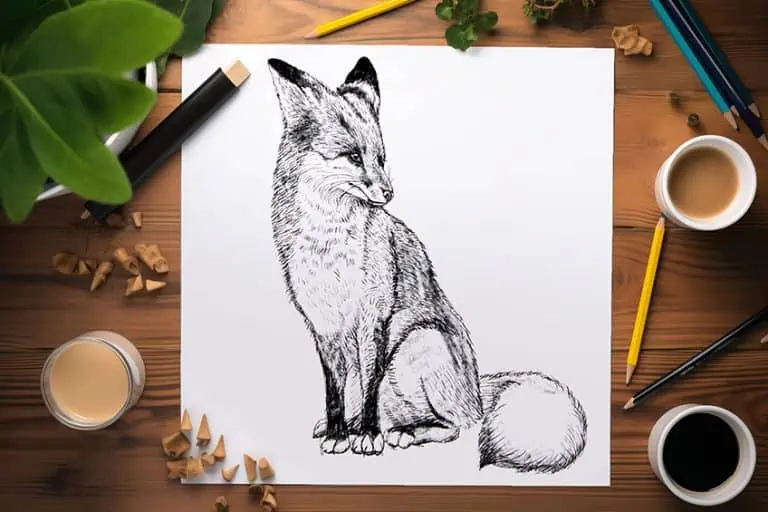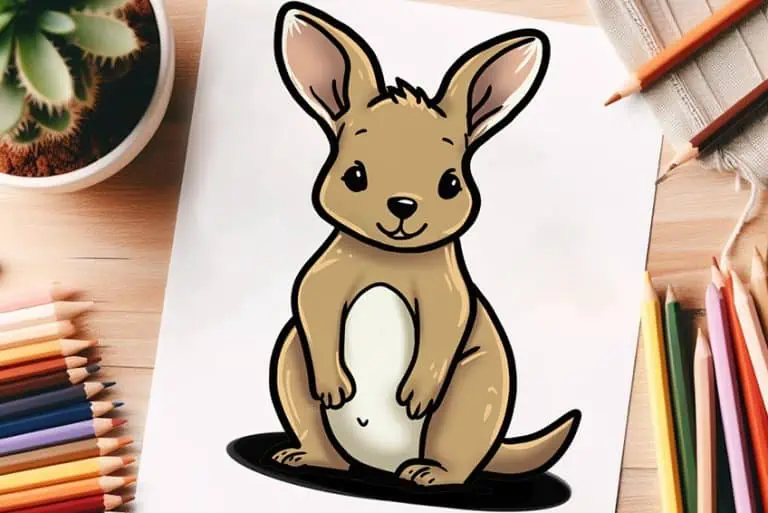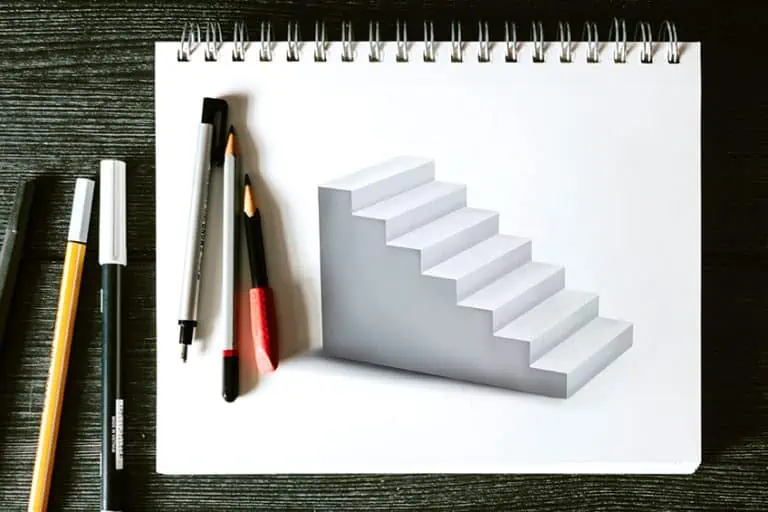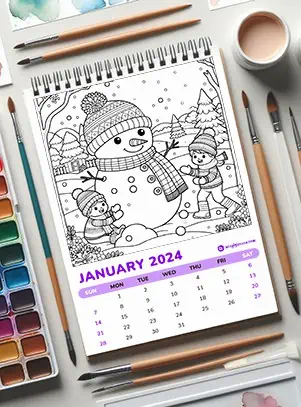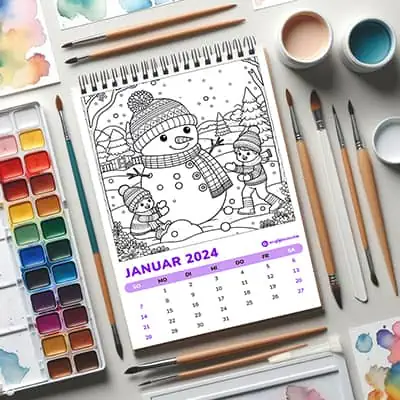Giraffe Drawing – How to Create this Fantastical Creature
This post may contain affiliate links. We may earn a small commission from purchases made through them, at no additional cost to you.
Learning how to draw a giraffe is a great drawing exercise due to the animals unique exterior. Giraffe drawings can provide us with the interesting task of representing a very specific structure. Giraffe faces are also very specific and come with a particularly beautiful set of features, which can be really fun to draw. This strange yet fantastical creature can also be used in so many interesting artworks and drawing ideas. Giraffe drawings provide us with not only an interesting learning curve but can be a great addition to our drawing repertoire as well!
Table of Contents
- 1 An Easy Guide on How to Draw a Giraffe
- 2 Step-by-Step Guide on How to Draw a Giraffe
- 2.1 Step 1: Sketching the Giraffe
- 2.2 Step 2: Refining the Giraffe Sketch
- 2.3 Step 3: Adding Base Color to the Giraffe Sketch
- 2.4 Step 4: Adding Darker Colors to the Giraffe Drawing
- 2.5 Step 5: Adding Color to the Giraffe Pattern
- 2.6 Step 6: Adding Color and Details to the Head of the Giraffe
- 2.7 Step 7: Adding Highlights and Shadows to the Giraffe
- 3 Tips and Tricks to Remember
- 4 Frequently Asked Questions
An Easy Guide on How to Draw a Giraffe
A giraffe’s head, face, and general form can seem quite complicated at first glance. However, we will learn that because it is so strange, it makes it quite simple to draw. The iconic features of a giraffe make a giraffe drawing quite specific and therefore unmistakable. However, we will see how we will transform a simply drawn giraffe sketch into a beautiful and realistic representation of a giraffe through the process of some simple tricks with layered colors and detailing drawing techniques.
Necessary Materials
This tutorial on how to draw a giraffe is done with a digital device, however, all drawing processes are transferable to traditional drawing materials. Once you have all the necessary materials, make sure to find a space where you can engage and focus on the giraffe drawing tutorial and its necessary steps.
- Ballpoint Pen
- Micron Pens
- Pencil
- Eraser
- Sharpener
- Paper
Step-by-Step Guide on How to Draw a Giraffe
Giraffes can be drawn in various ways, however, for the best result possible we will draw a giraffe through a set of various simple steps. We will start by working through the giraffe’s head, where we work on all the necessary details in the giraffe’s face. We will then work our way through the giraffe’s body, making sure we have a simple drawn giraffe. From there we will start to implement colors to establish the base layers, which we will then proceed to work layers over with more colors. slowly taking our time, we will implement colors into our giraffe drawing, which we will then refine with some detailed linework and shading. Now that we know what to expect, let’s go through this easy giraffe drawing process.
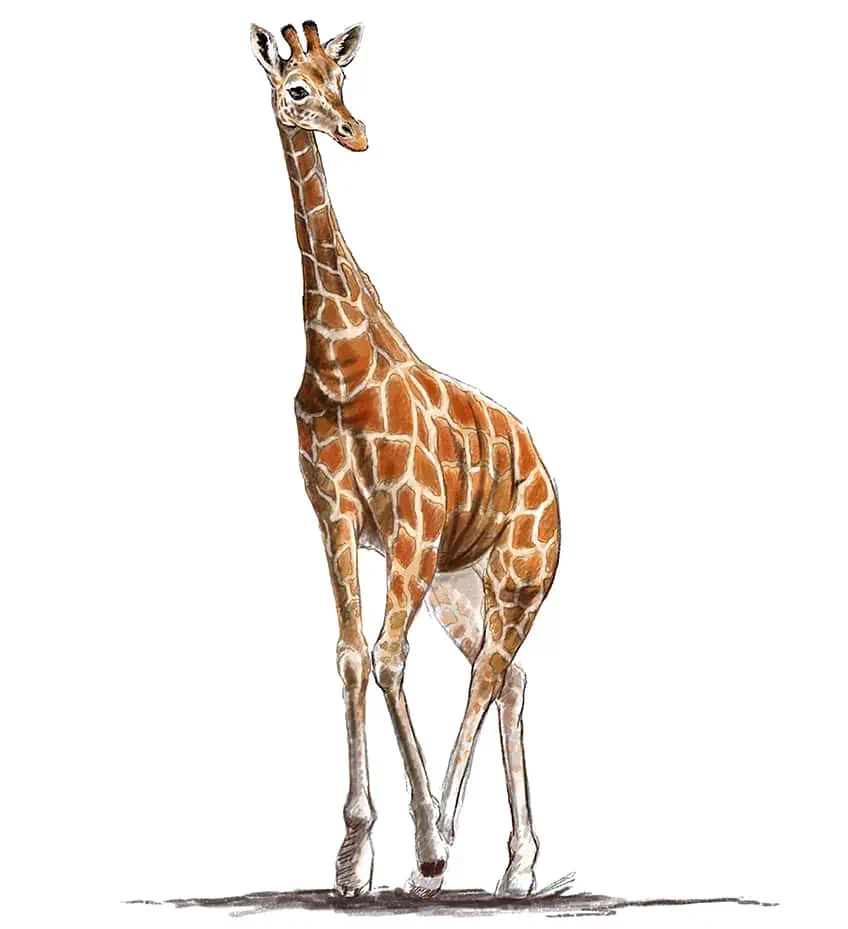
Step 1: Sketching the Giraffe
We want to start by establishing a simple giraffe sketch, where we establish the giraffe’s main features. We can start with the head of the giraffe, working on the general shapes in the head.
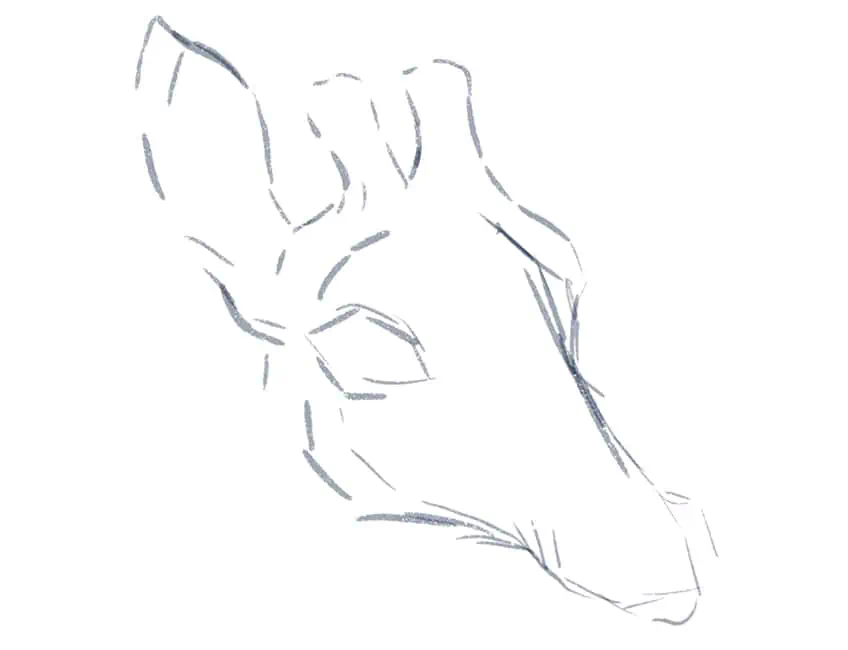
We want to keep the sketch quite light at this point, just working out the general features of the giraffe. This is where we can start to think about the pose and how we would like to position the giraffe.

The neck of the giraffe is quite long, perhaps three heads in length. We want to make sure that as it connects to the larger body, it becomes wider and has a cone-like shape.
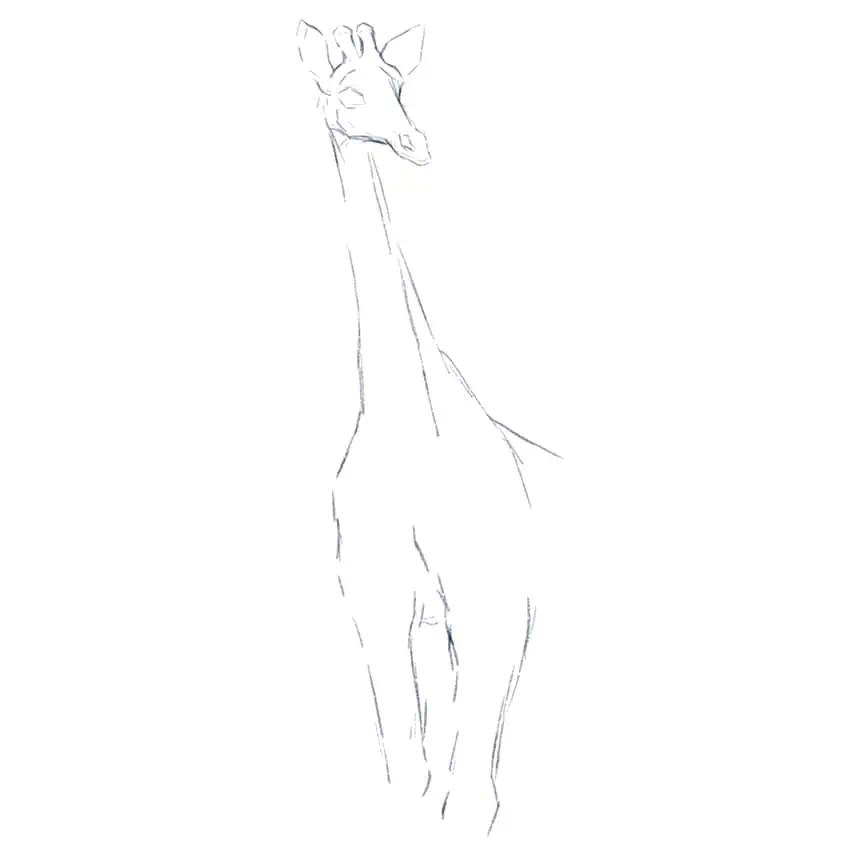
As we establish the body of the giraffe, we will see that the shape is quite round and circular, whereas the legs are very narrow. As we work through the legs, the legs become enlarged near the knees.
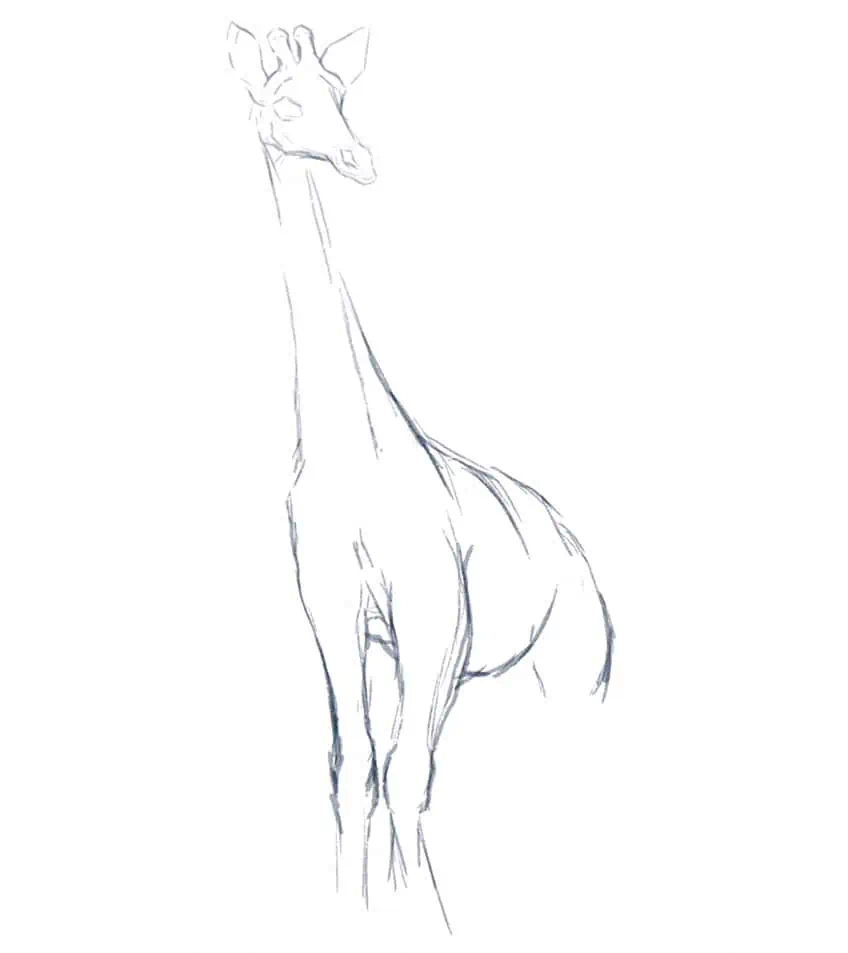
As we continue the drawing below the knees, we will find that the rest of the legs become narrow again before bulging near the hoof joint.

Step 2: Refining the Giraffe Sketch
Once we have established the basic shape of the main features, we can now start to refine them with detailed linework. This is where we can establish unique qualities a little more clearly, such as the eyes, ossicones, ears, and so on.
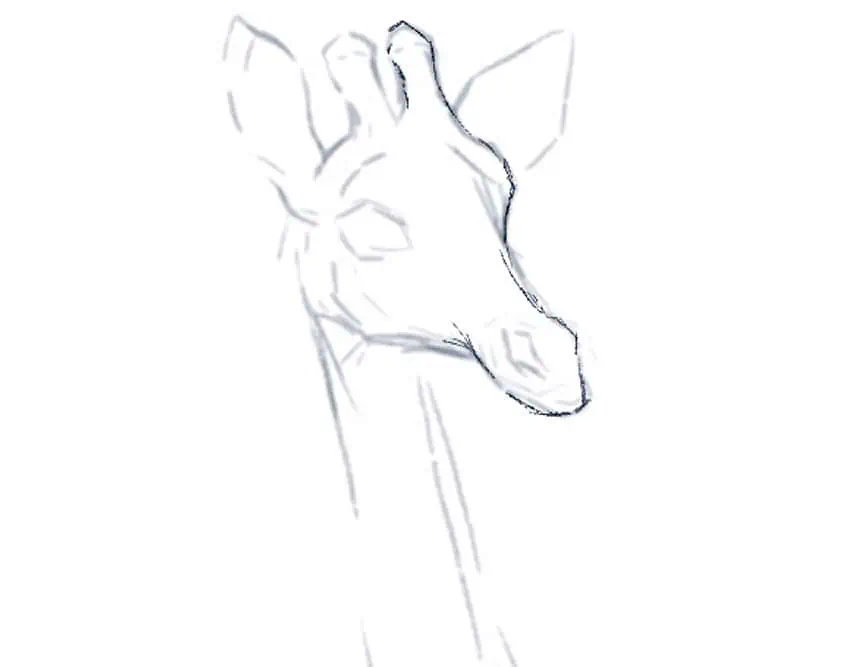
We want to take our time working through the head, making sure we capture the various aspects of the face. We can also start to work some outlines into the neck, capturing the cone shape.

As we work our way through the body of the giraffe, we can start to outline the front legs and how they connect to the rounded body. We can also add more shape to the hind legs and how they flow into the back of the giraffe.
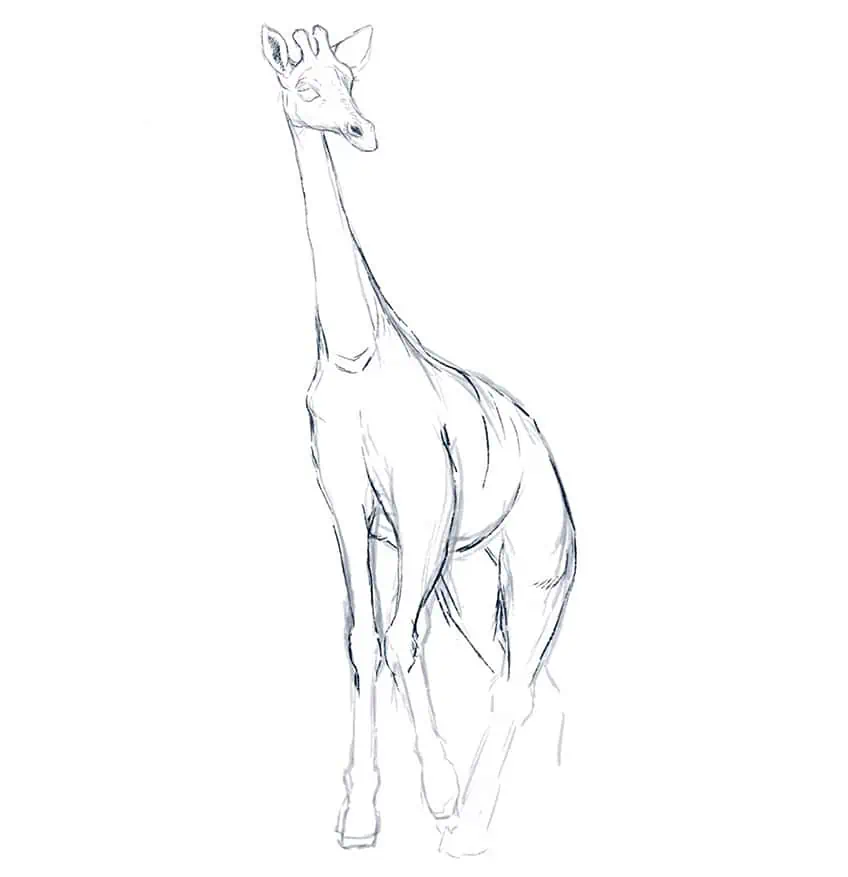
We want to take our time with how we shape the legs and how they are in scale and proportion to the rest of the body. You still want to keep your sketch light at this stage while you work out the proportions of the giraffe drawing.
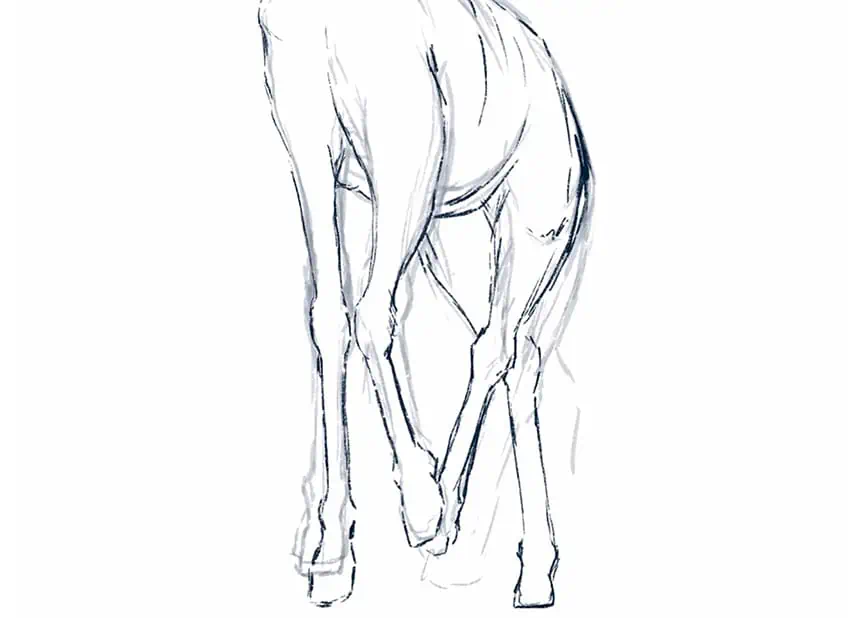
Step 3: Adding Base Color to the Giraffe Sketch
Once we have established the giraffe with a light sketch, we can then start to work in some base colors into the giraffe. Giraffes have various hues that shift between hues of browns and oranges.

The intention should be to start with light tones of browns, and then slowly work with layering darker colors, slowly building up darker tonal values.

At this stage, we want to start considering the direction from which the light source is coming and how this will cause shadow formations around the giraffe. We want to represent these shadows with darker hues of brown to maintain the right coloration in the giraffe.

As we work through these base layers of color, we can start to work in the patterns of the giraffe. The patterns can be described as these square-like tiles that become smaller, the narrower the body part.
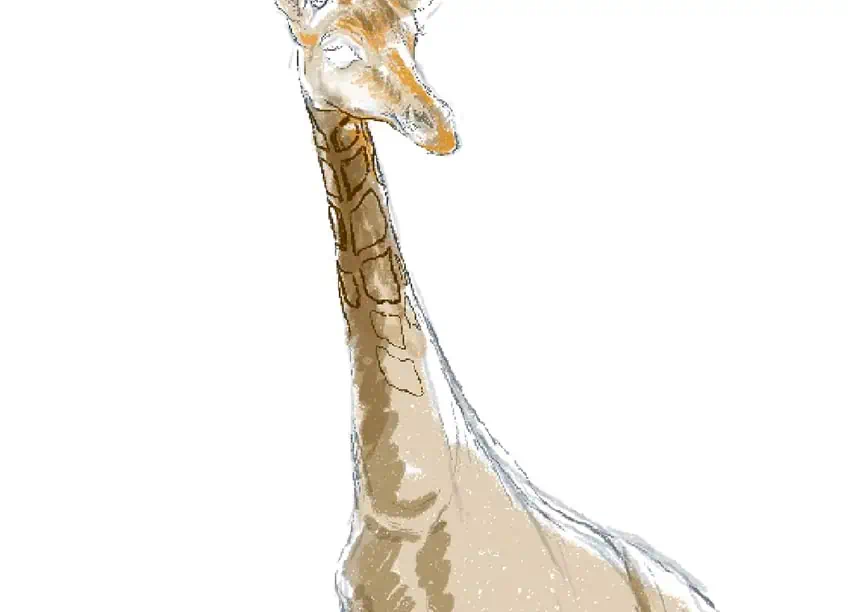
This means that the pattern shapes will become smaller as they flow into the giraffe’s neck and legs. These patterns become increasingly smaller in the legs as the legs become thinner.
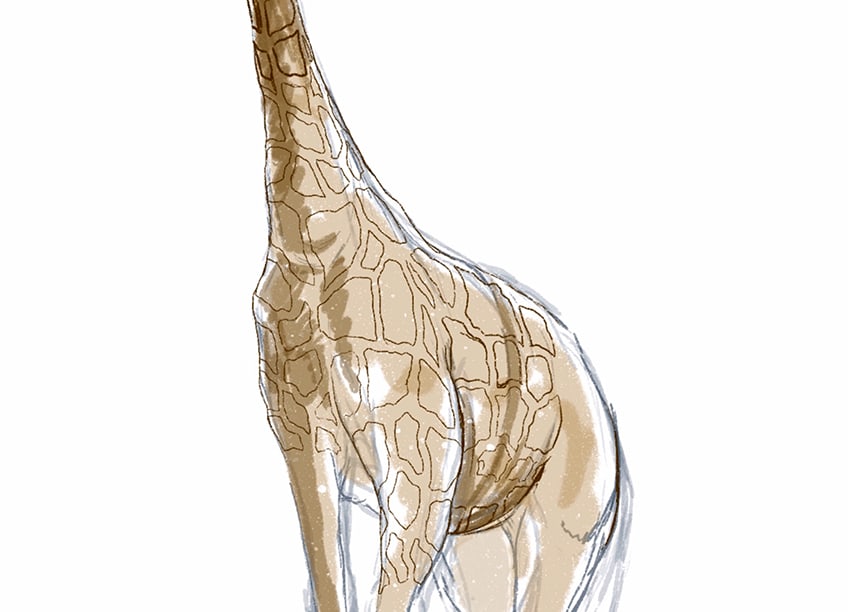
We also want to make sure that the patterns flow around each body part, emphasizing their particular shape. This means we want to add curvature to these shapes as they form around curved surface areas in the body.
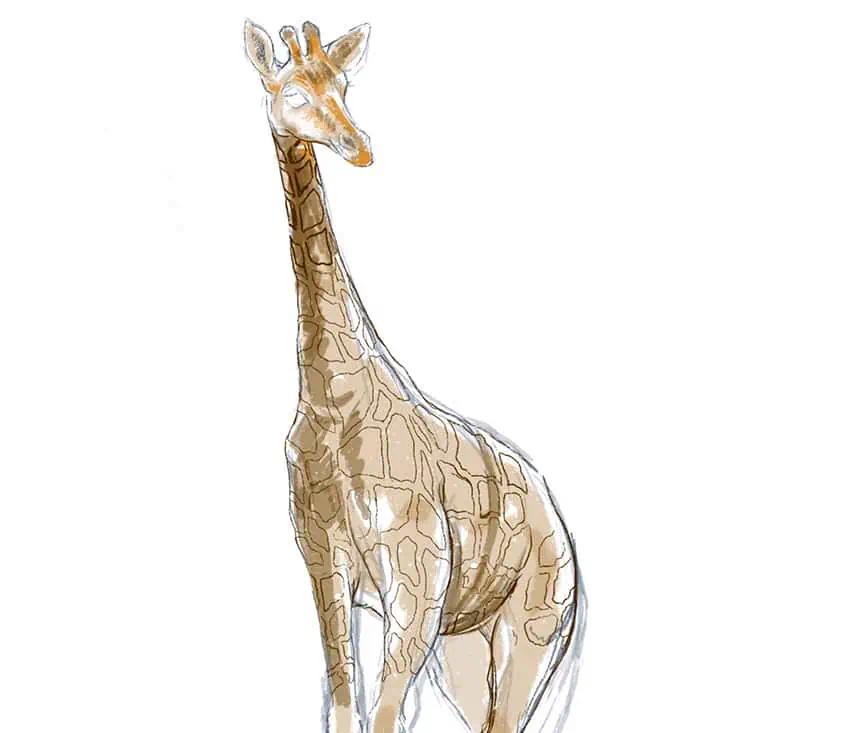
The intention is to take your time with building up layers of color, working from lighter to darker tonal values. As you build up tonal values from lighter colors, you will have more control over the mark-making process.

Step 4: Adding Darker Colors to the Giraffe Drawing
We also want to be thinking about the pose and stature of the giraffe drawing, and how it would be positioned towards the light source. This will inevitably have an effect on the shadowing and along what side of the giraffe it forms.

Take your time working in some shadowed marks with some darker brown colors, this way you maintain the correct color palette as you do so. By the integration of shadows, we will also start to see how it emphasizes the three-dimensional nature of various features in the giraffe sketch.
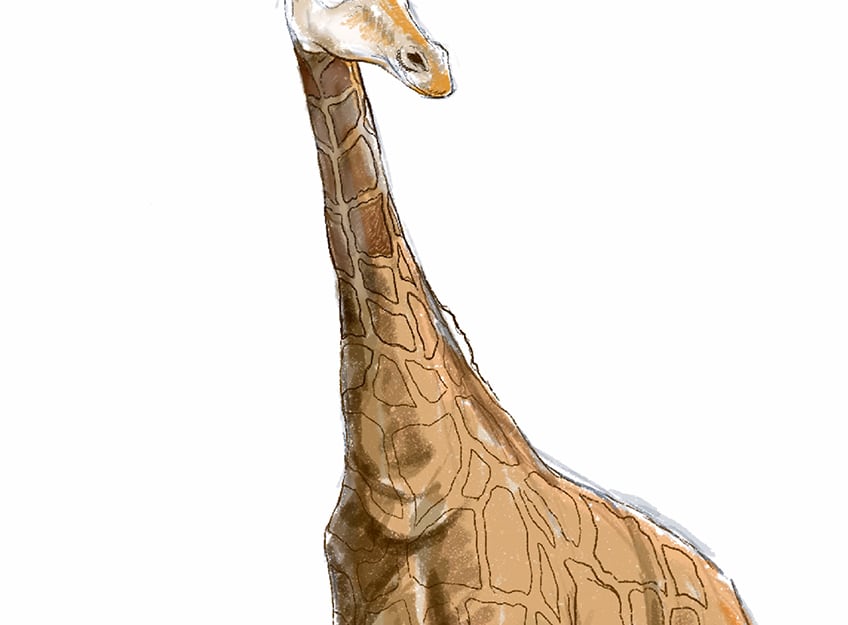
We also want to think about the anatomy and how different aspects of the giraffe have different shapes. For instance, the chest will have these wrinkles, which are a result of how the neck connects to the chest.
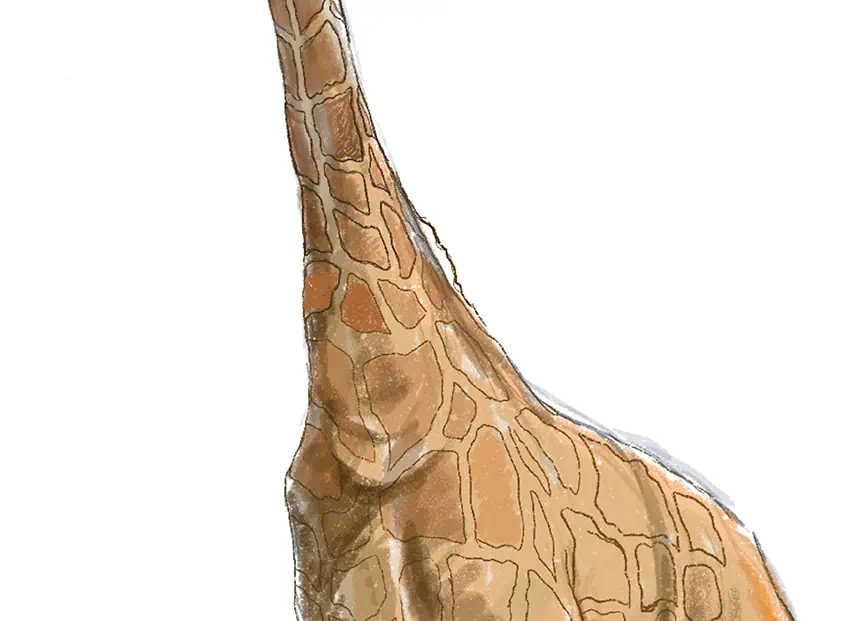
Step 5: Adding Color to the Giraffe Pattern
This is where we can start to integrate some reds and browns into the patterns of the giraffe, slowly filling them in. The intention is to work with warm reds and browns, also keeping in mind which sides of the giraffe are lighter or darker.
A good suggestion is to use lighter colors near areas of the giraffe that are illuminated. However, you can use darker colors in areas where there are more shadows present.

You also want to make sure that as you add color to these patterns, you want to keep the legs fairly light in tonal value compared to the rest of the body.

Take your time slowly building up the colors within the various patterns that are present in the drawn giraffe. We also want to make sure we keep the patterns smaller in scale as we shift towards the thinner and smaller features of the giraffe, such as the narrow legs.
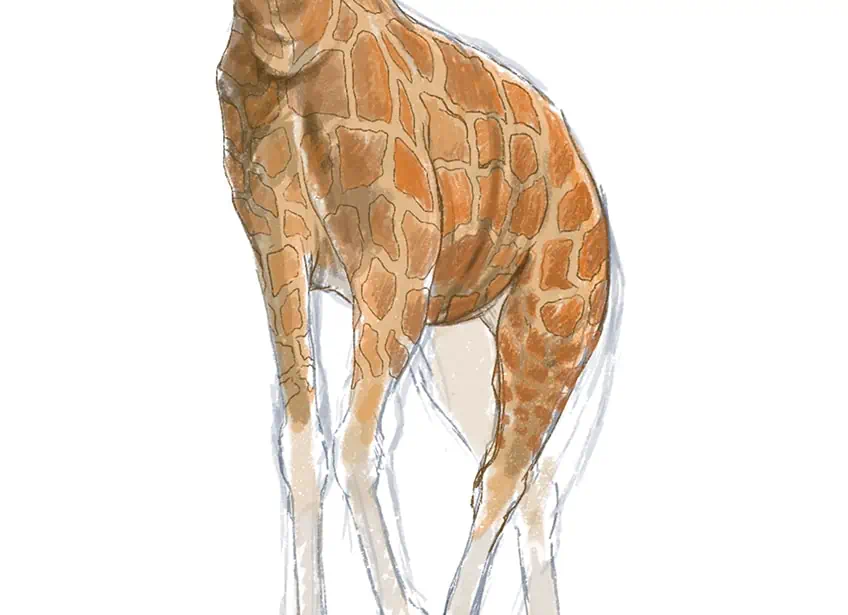
Remember to keep in mind that the patterns will become darker near shaded areas. We want to take time with filling in the patterns, making sure we use the right color palette between

We now want to work in some shadows over the pattern, by doing this we cover the body with shadow formations in a way that seems realistic.
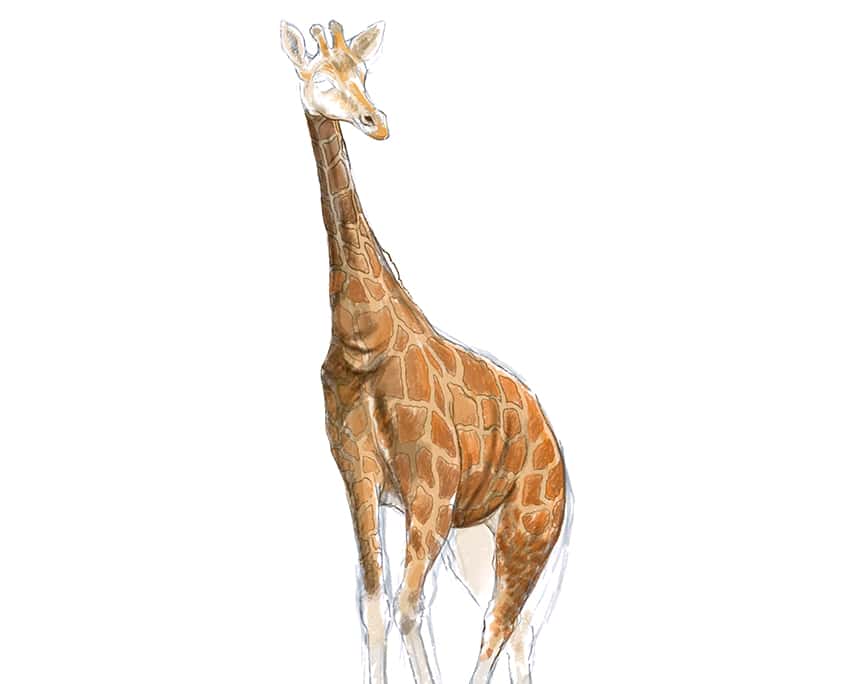
This is where we want to think about the creases and wrinkles in the skin and how they form along the body of the giraffe. We can represent these features by integrating darker colors of brown.

Continue with this process of working with patterns and shadow formation. Again, make sure to keep the legs lighter in coloration both in the legs and pattern color.

Step 6: Adding Color and Details to the Head of the Giraffe
We can now shift our attention to the giraffe head where we follow the same process of building up colors in the giraffe face, using orange, red, and brown hues.

We can also darken the eye, making it black with hints of brown to emphasize the curvature in the eyeball. We can also add highlights to the giraffe’s eyes to emphasize the glossy surface.
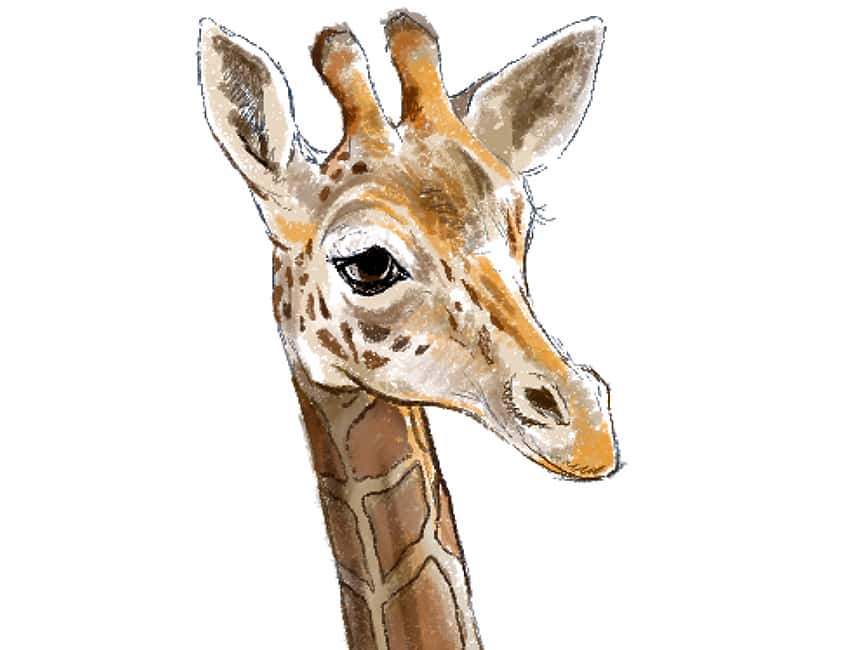
We want to make sure we maintain the orange/red hue within the giraffe’s face, we can also keep the colors light around the giraffe’s eyes. The giraffe’s head has smaller patterns that form alongside the face around the giraffe’s eyes.

Take your time building up colors with layers, making sure to work in some darker details to emphasize the nose, eyes, and ears. We want to make sure we use colors to strategically represent both illuminated and highlighted areas in the giraffe.
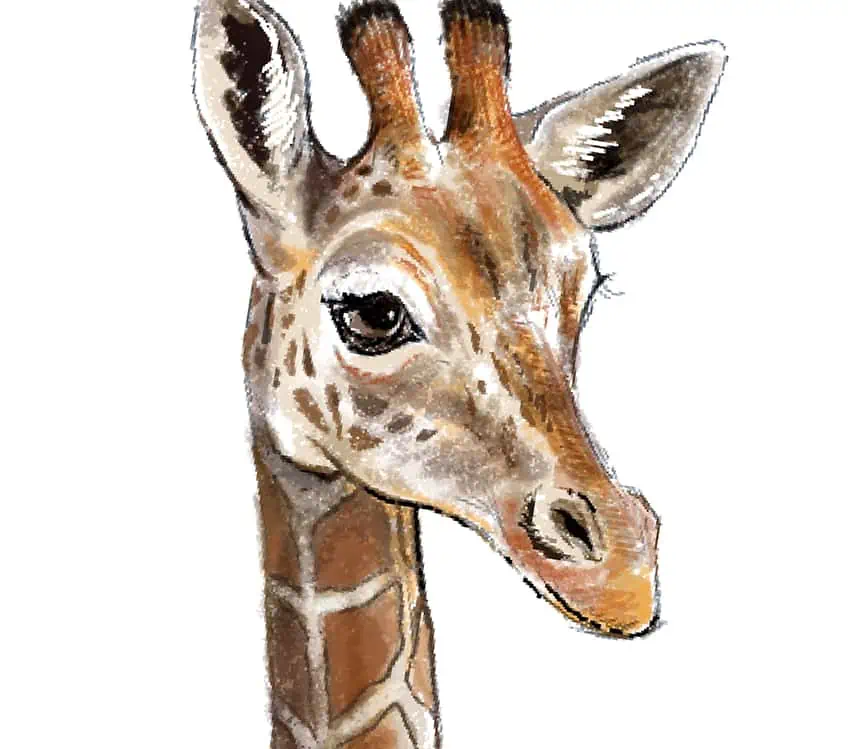
Step 7: Adding Highlights and Shadows to the Giraffe
This is where we can now work in some lighter tones around the pattern to represent the lighter qualities of fur in the giraffe drawing. When drawing giraffes, a good idea is to work in the lighter qualities towards the end.
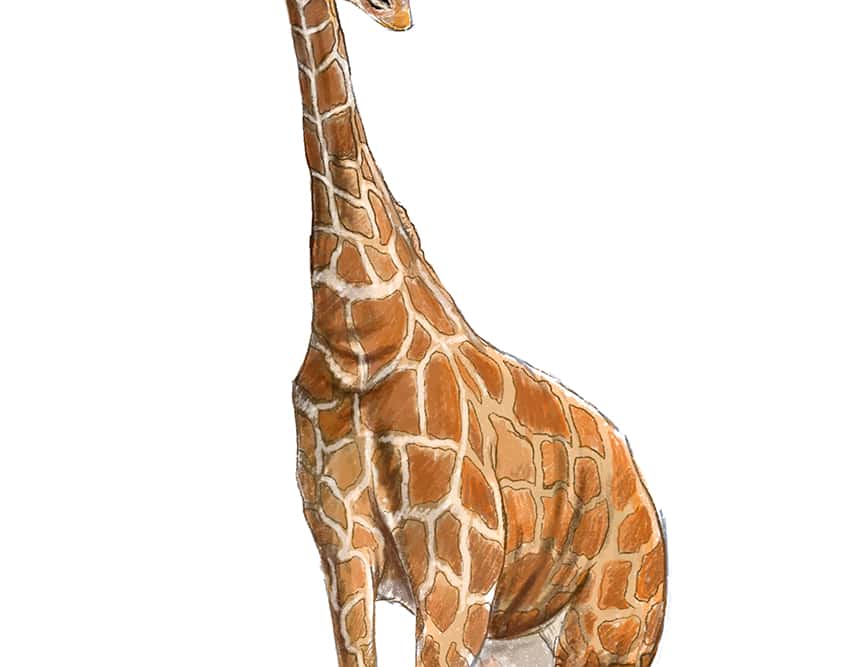
Take your time working carefully around the pattern, ensuring that you maintain the right color values within the patterns of the giraffe.

We want to make sure we work in these lighter colors around the pattern throughout the entire giraffe drawing. As we do this we will see how it resembles a more realistic quality in the giraffe drawing.
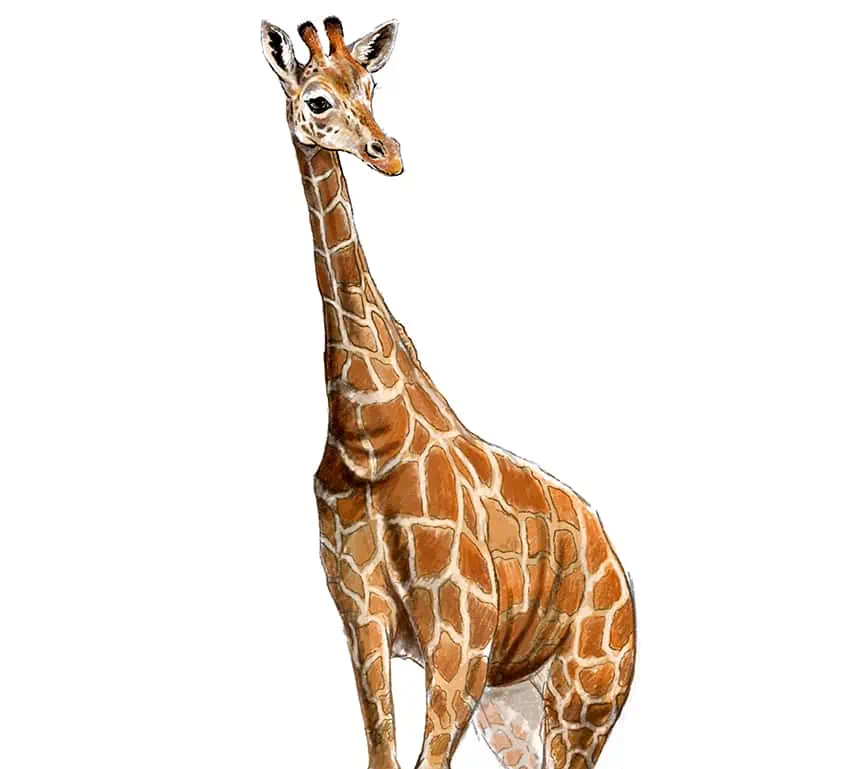
And then lastly, we want to go over the shadow formations one last time within the entire giraffe drawing. from the giraffe head, all the way through to the hooves, we want to make sure we work shadows overall features that require shadows.
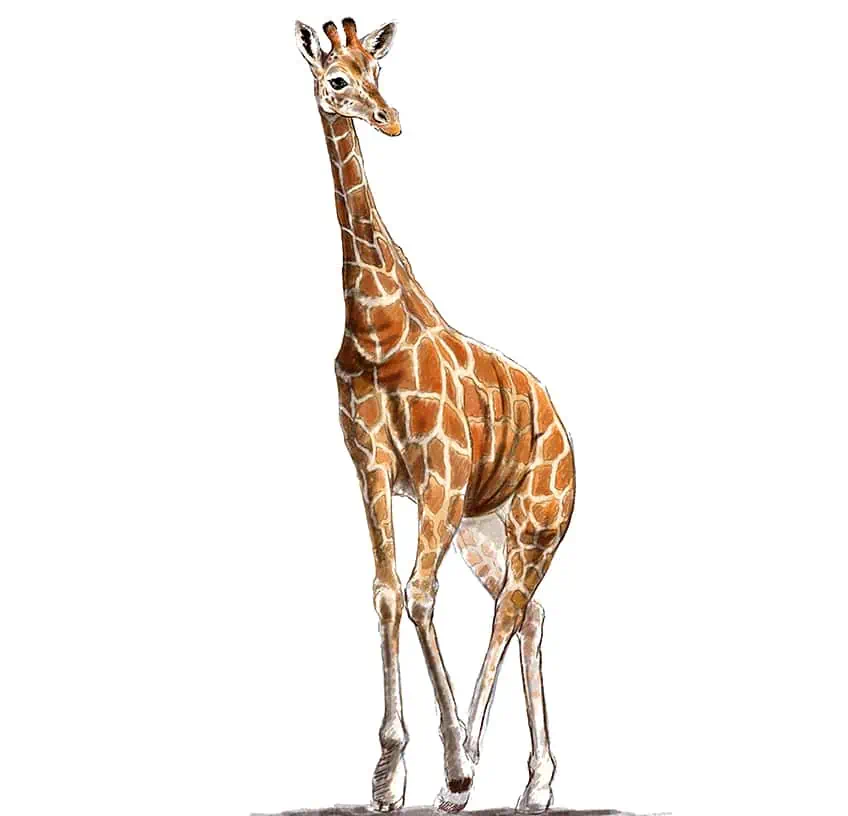
Make sure you work in shadow formations into the legs as well, keeping them consistent throughout the entire body of the drawn giraffe.

There you have it! an easy giraffe drawing done within a few simple steps. Giraffe drawings can be approached in many ways, however, this easy giraffe drawing demonstrates how to use layers to build up your giraffe drawing.
Tips and Tricks to Remember
- Work out a basic sketch. Work out the shape of the giraffe’s head, and then the features of the giraffe’s face.
- Take your time with both your head and body. The giraffe head has a unique set of features that we want to spend time on.
- Layering colors from lighter to darker tonal values. It’s always good to build up colors from lighter to darker tonal values. This way, you have more control over your mark-making process throughout your giraffe drawing.
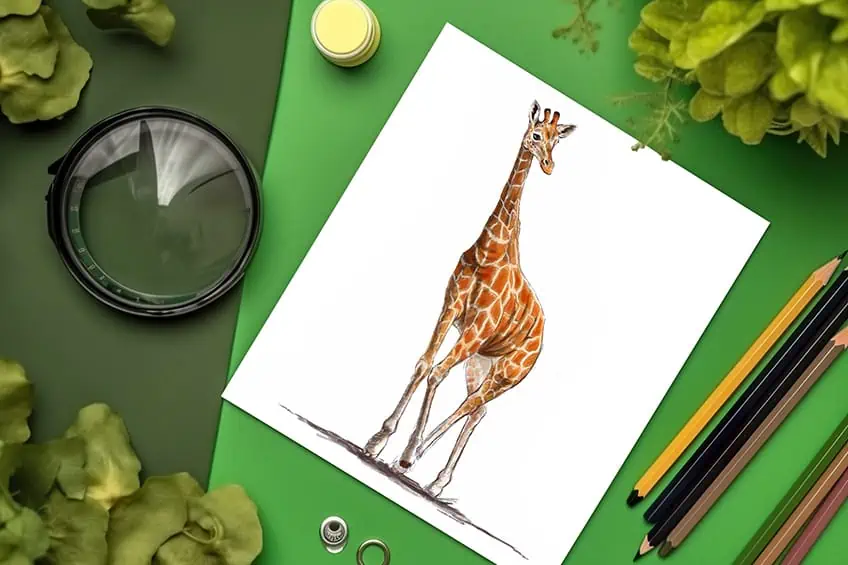
Giraffe faces are very interesting and have such a beautifully unique aesthetic. Taking your time with the giraffe head will give you a better sense of scale and shape than the rest of the animal. When drawing giraffes, always be sure to break up the process into two main sections; working on the complicated giraffe head structure, and then working your way through the body.
Frequently Asked Questions
How Do You Draw the Patterns of a Giraffe?
Giraffe patterns can be described as a set of tiles that are placed compactly alongside one another. The giraffe head is quite subtle with the pattern, and we will find that they get smaller as they surround the facial features. However, as these patterns extend down the body, they become significantly larger. The patterns are quite hexagonal, however, they are never consistently the same in shape. This gives us a lot of freedom to create patterns in various sizes. The patterns also get smaller as they shift down the narrow structure of the giraffe’s legs.
How to Draw a Giraffe’s Neck?
The neck of the giraffe is quite large in proportion compared to the rest of its body. The neck of the giraffe has a cone-like shape that becomes more narrow as it flows from the base of the neck into the giraffe’s head. The neck is also filled with large tile-like patterns that become smaller as the neck becomes more narrow near the head. These patterns become slightly larger as they flow into the chest of the giraffe. The neck is also quite large in width compared to the rest of the body. The neck becomes narrow near the giraffe’s head, but enlarges as it connects to the body of the giraffe.
Matthew Matthysen is a multidisciplinary artist. He completed his fine art degree, majoring in History of Art and Contemporary Drawing Practice at the University of Witwatersrand, South Africa. Before joining acrylgiessen In 2020, Matthew worked part-time as an art teacher at Reddford Blue Hills High school. Matthew creates drawing and painting tutorials for acrylgiessen and captures them not only photographically and in written form. He also records the creation of his works in his own creative studio as in video format, from which later with a voiceover and a video editor also drawing tutorials for the Youtube channel of acrylgiessen are created.
Learn more about Matthew Matthysen and about acrylgiessen.



